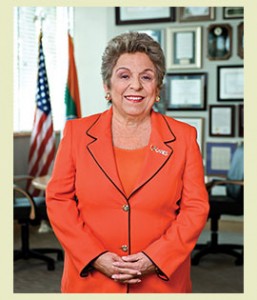Donna Shalala and The Boom Boom Theory

Connector.
Donna Shalala spoke at a breakfast meeting at the University of Denver (DU) the other day. She seems to be one of the most connected people on earth. She’s the former president of Hunter College, the University of Wisconsin, and the University of Miami. She also served for eight years as the Secretary of Health and Human Services during the Clinton administration. Perhaps most impressive (to me at least), over ten years at the University of Miami, she raised three billion dollars in voluntary contributions.
Our chancellor, Rebecca Chopp, interviewed Shalala before an audience of some 300 faculty, alumni, and students. The conversation soon turned to inclusive excellence (IE), which is a fundamental initiative at DU. We define IE as, “…the recognition that an … institution’s success is dependent on how well it values, engages and includes the rich diversity of students, staff, faculty, administrators, and alumni constituents. … The goal is to make IE a habit that is implemented and practiced consistently throughout …” the university.
Chancellor Chopp asked Shalala what advice she could offer to build an inclusively excellent university. Shalala’s answer reminded me that multi-channel communication is fundamental to multi-cultural success.
In a diverse community, Shalala noted, people have diverse communication styles. They may use the same word for different concepts. Or they may describe the same concept with different words. Further, they may well be tuned in to different channels.
Given the varying communication styles, Shalala argues that leaders of diverse communities need to deliver the same message multiple times, in multiple ways, through multiple channels to make sure it reaches all audiences. Shalala’s staff called this the Boom Boom theory of communication because one message (“Boom”) gets repeated across multiple channels.
It’s a good reminder that we need to repeat ourselves, perhaps more often than we think. I’ve written before that redundancy is not a sin; Shalala argues that we need to actively promote redundancy. Coupled with a concept like the sponsorship spine, the Boom Boom theory can produce effective communications in even the most diverse organization.
And what about those three billion dollars? Shalala says there’s no secret to fundraising. It requires a lot of patience and listening. Find out what your contributors are interested in and deliver it.
But patience and listening only take you so far. Shalala also reminded us of the value of good old-fashioned story telling. At fundraising events, she doesn’t talk about abstract concepts or programs or buildings. She simply tells stories. She admits that some of her stories “leave ‘em weepy” – they’re touching and effective. She wants her contributors to reach for their wallets. So first, she has to reach for their hearts. Combining the Boom Boom strategy with the leave-em-weepy tactics seems to be a killer combo.
Best of Breed Education

Baby Talk – Competency Level 1
When Elliot was a teenager, he went off to a weeklong sailing course approved by the Royal Yachting Association (RYA) in Britain. He passed with flying colors and received an International Certificate of Competence as a Sailing Crew Member – Level 1. The certificate attests to one’s “ability and provides documentary assurance from one government to another that the holder meets an agreed level of competence….”
With his certificate in hand, Elliot could serve on any sailing crew that requires Level 1 competency. He could also take his certificate to any other RYA-approved sailing school and immediately enter the course to achieve Level 2 competency. He could choose the next sailing school based on schedule or location or teacher or whatever. Not only does Elliot know something but his knowledge is also certified in a manner that’s globally recognized. That means he has a wide array of choice and options – he’s a free agent.
Why couldn’t higher education work the same way? Why can’t we flip the educational model to make it student-centric? Why can’t a student accumulate knowledge from a variety of sources and then have it certified in a globally recognized manner?
For instance, my online students at the University of Denver clearly want to acquire knowledge that will afford them broader skills and opportunities. Some are pursuing knowledge for the sake of knowledge. But many students also want that knowledge to be certified. Since the University grants the certification, students are incented to take courses only from one institution. It’s an institution-centric system.
Now the University of Denver is a great school but why couldn’t one of my students – perhaps living in Montana – also take online courses from New York University and the University of Toronto and the London School of Economics plus some on-campus courses at Montana State and have it all count toward a Master’s degree? In fact, why couldn’t she also acquire knowledge from workshops offered by the local Chamber of Commerce or a chapter of the Project Management Institute and also have that knowledge count toward a degree?
Why couldn’t she bundle it all together and have it certified as the equivalent of an MBA? We can certainly imagine that courses from multiple sources might offer a richer, more varied, and perhaps higher quality education. Every university has some good teachers and some not so good teachers. Why not select the best teachers and best courses from multiple institutions rather than taking all courses from only one school? Let’s call it best-of-breed education.
To deliver student-centric, lifelong, best-of-breed education, we’ll need to develop several new processes and agencies. The good news is that several of them are already under way. Let’s talk about them tomorrow.
Are MOOCs For Rich People?

It’s not what I expected.
When I was an undergraduate at the University of Delaware, I worked in the College Try program, which reached out to students who were traditionally underserved by the university. This generally meant ethnic minorities and/or students from poorer families.
The program provided extra assistance to prepare students to succeed in university. For two summers – after their junior and senior years of high school – the students lived on campus for six weeks and took college preparatory courses. We aimed to get them prepared academically and socially for university (and dormitory) life.
When the students arrived as freshmen, they took classes with our best teachers and received extra tutorial assistance. I was one of the tutors for the first two years of the program. I lived in the same dormitory with the students and was available day and night.
I thought College Try was an exceptionally well-designed program. Unfortunately, it doesn’t seem to have worked. I just checked the ethnicity statistics for the University of Delaware and they don’t look much different from when I was there.
So, how can we provide the benefits of higher education to traditionally underserved students? As MOOCs grew in popularity over the past several years, I thought they might hold the answer.
MOOCs – Massive Online Open Courses – take the best classes from the best professors and put them online. Anyone with Internet access can take them. There are no entry or residency requirements. Typically, they’re free or very inexpensive. We’re still sorting out how to give credentials for participating in MOOCs but I think we’ll soon iron out the details. Meanwhile, the knowledge is there for the taking.
I teach online courses at the University of Denver. Technically, they’re not MOOCs (we charge tuition) but they’re very similar. I can personally attest that online education can be very effective. It’s different than the classroom but still quite engaging. Based on my experience, I believe that MOOCs can offer many of the benefits of higher education, especially at the graduate level.
So, are MOOCs reaching traditionally underserved students? Are they democratizing access to higher education? Unfortunately, the early results are disappointing. I base this on two recent developments.
The first development is Udacity’s “pivot” away from higher education and toward the corporate training market. Udacity is one of the pioneers of the MOOC movement and its pivot has drawn a great deal of attention. Several articles (here, here, and here) suggest different causes, including poorly designed software, very high attrition rates, and a lack of focus.
For me, the most telling statistic is that successful Udacity students are people who are already quite well educated. The typical person who completes a course already has a Bachelor’s degree and often holds graduate degrees as well. Udacity succeeded in educating the educated, not the uneducated.
The second point comes from the University of Pennsylvania, which surveyed 34,000 students who began at least one of the University’s 24 MOOC classes (based on the Coursera platform, a Udacity competitor). The survey found that most students were “well educated, employed, young, and male.” In other words, not the traditionally underserved.
I suspect that MOOCs may be caught in the hype cycle that’s described by the Gartner Group. We’ve seen the peak of inflated expectations and we’re now entering the trough of disillusionment. Perhaps in a year or two, we’ll get to the slope of enlightenment and ultimately arrive at the plateau of productivity. I personally think that MOOCs have a lot to offer. But we still have a long, strange trip ahead of us.